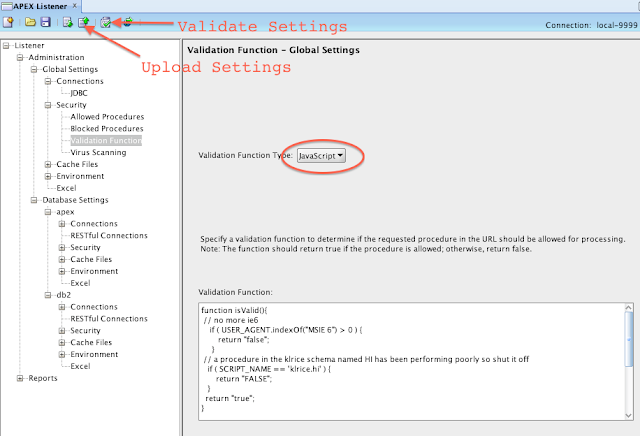The command line has a options now.
$ java -jar apex.war help java -jar apex.war[Options] [Arguments] The following commands are available: configdir Set the value of the web.xml config.dir property help Describe the usage of this program or its commands map-url Map a URL pattern to the named database connection migrate Migrate a 1.x configuration to 2.x format setup Configure database connection standalone Launch Oracle Application Express Listener in standalone mode static Generate a Web Application Archive (WAR) to serve Oracle Application Express static resources user Create or update credentials for a user To see instructions on how to use each of these commands, type help followed by the command name, for example java -jar apex.war help configdir If no command is provided the Listener is started in standalone mode
The important one to not using the command line is the "user" command. You can use sqldeveloper 3.2.2 to now administer the APEX Listener. The user command lets you setup the authentication that sqldev will use to connect and administer in standalone mode.
java -jar apex.war user klrice "Listener Administrator"
SQL Developer 3.2.2 is the current and required version to administer the listener. Use the View -> APEX Listener menu and change anything. Once the settings are done, use the test button in the tool bar to validate setting and finalize with the Upload Setting button. Alternatively, you can save the setting to a zip file and manually put them in place.

Java Script Validations?
In the new listener there's an option for the normal PL/SQL Validations. Nothing has changed there however if you change the select box to javascript, you can now validate the request before hitting the database at all. This has the obvious advantage of no database hit, no connection borrowed from the pool, no extra load on the database to simply refuse some requests. The following are all available in javascript as variables.HOST PORT REFERER USER_AGENT URI QUERY_STRING REMOTE_ADDR REQUEST_METHOD REQUEST_PROTOCOL REQUEST_SCHEME SCRIPT_NAME SERVER_NAME SERVER_PORT SERVER_PROTOCOL
Also all querystring params and headers are put in as variables with their names.
The only requirement is that there be a function named "isValid" that returns the string "true" or "false".
function isValid(){
// no more ie6
if ( USER_AGENT.indexOf("MSIE 6") > 0 ) {
return "false";
}
// a procedure in the klrice schema named HI has been performing poorly so shut it off
if ( SCRIPT_NAME == 'klrice.hi' ) {
return "FALSE";
}
return "true";
}















